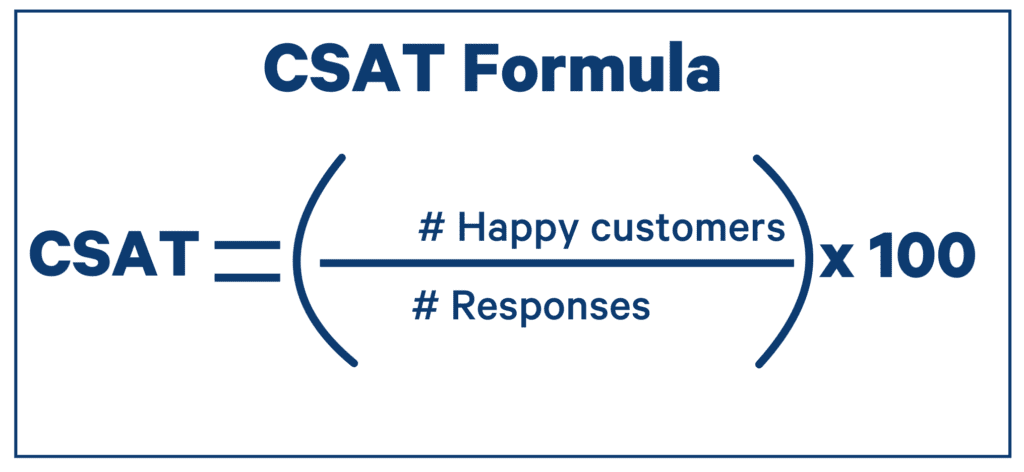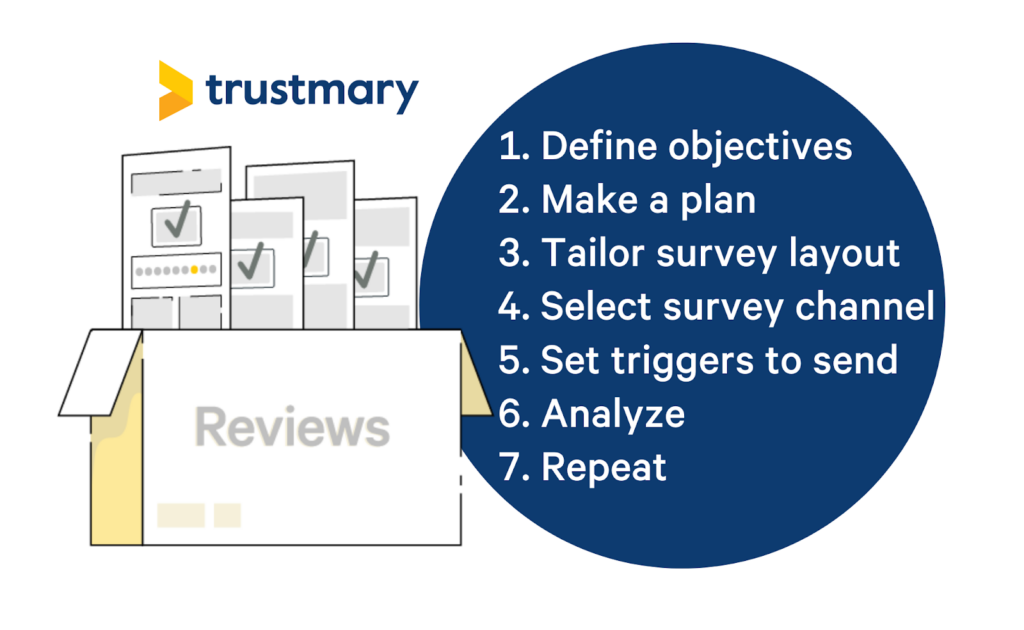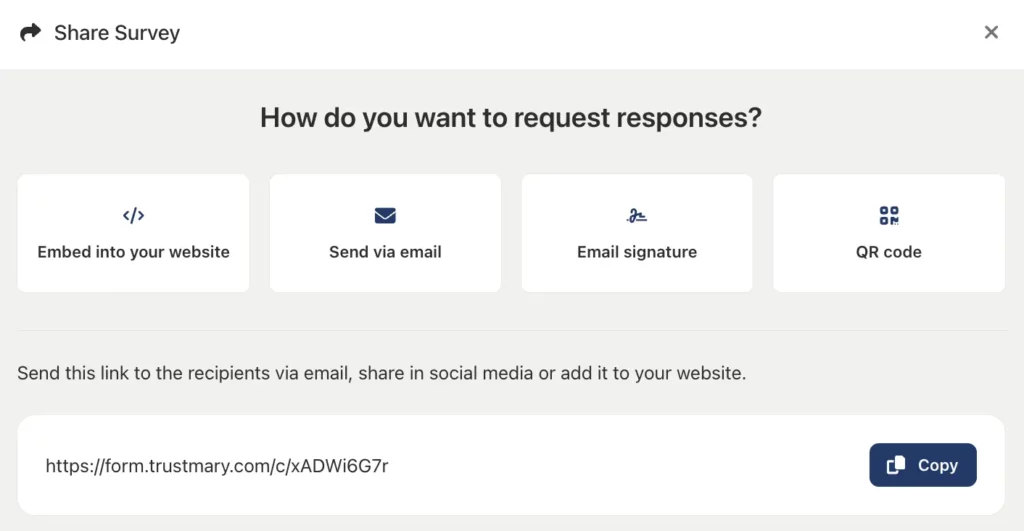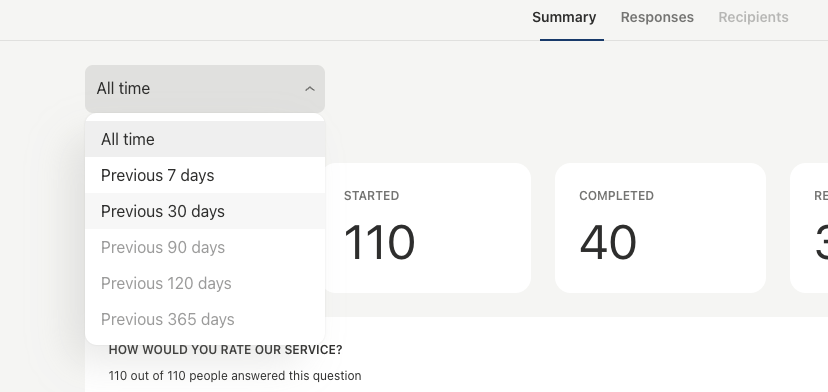How Customer Satisfaction Score (CSAT) will help your business? 7 examples

In today's world, consumers have more power than ever before. It's past time for businesses to take advantage of consumer feedback to boost CX and create loyal customers.
Most companies are already using customer feedback, but they're usually missing something significant: a standard for measuring customer satisfaction.
If you care about giving customers a good buying experience, you should track their satisfaction level. 80 % of companies use customer satisfaction scores to know what they think and feel. That helps them make the right changes and improve their business.
You've probably heard the term CSAT thrown around by marketing experts and business gurus. Still, you're wondering what exactly it entails.
Don't worry; this article will describe:
- The meaning behind CSAT, its formulation, and calculation
- What is a good customer satisfaction score?
- The difference between CSAT, NPS, and CSI
- 7 examples of CSAT helping businesses grow and relevant benchmarks
So, without further ado, let's get started.
Customer Satisfaction Score (CSAT) Explained
What Is The Customer Satisfaction Score (CSAT)?
Customer Satisfaction Score (CSAT) measures the customer's satisfaction level with a brand or product/service. It can be thought of as a grade or percentage value representing how much the customers like your product.
It is the simplest way to gauge customer loyalty and satisfaction, helping your company make crucial decisions about its business.
Calculating Customer Satisfaction Score (CSAT)
CSAT ranges from 1 to 10 (or 100%). A low score (1-6) indicates that you need to improve service quality, while a high score (8-10) implies that you are doing great.
The CSAT score is obtained by asking customers a simple question which is:
"How satisfied are you with your product/service?"
The answer can be in the form of:
- A number selection ranging from 1-3, 1-5, or 1-10
- Words like very unsatisfied, unsatisfied, neither satisfied nor unsatisfied, satisfied, very satisfied.
- Symbols such as smileys or stars.
Regardless of the representation of the answer, the value of the score remains the same.
The Customer Satisfaction Score (CSAT) Formula
Once you have the score, you can feed it in the following formula to calculate your CSAT percentage:
CSAT = [No. of satisfied customers (4 and 5)] / [Total number of responses] x 100
This formula takes only the number of responses where the customer has selected 4 and 5 on a scale from 1-5.

Example 1
For example, you ask 200 customers, "How satisfied are you with our services?" 90 customers answered "satisfied," and 50 answered "very satisfied."
The CSAT calculation would then become:
CSAT % = [90 + 50] / [200] x 100
which is equal to:
CSAT % = 60%
Example 2
However, suppose the number scale is 1- 10, then the calculation will be a little different. In this case, the CSAT calculation will become:
CSAT % = Sum of Response Score / Maximum Possible Score x 100
Let's say you asked, "What rating would you give our services today?" to five customers and get the following results.
In this case, your CSAT will be:
CSAT % = 37.5 / 50 x 100
which is equal to 75%.
Example 3
If you are working with verbal scale such as satisfied and very satisfied, you can give each answer a numerical score such as very unsatisfied = 1 to very satisfied = 5.
Furthermore, if you use symbols like stars or smiley emoticons, you would multiply by 5 (or whatever the maximum possible answer is) instead of 100.
Factors That Help Improve Customer Satisfaction Score (CSAT)
Many factors can encourage customers to like your services. I have mentioned three main factors below:
- Speed: How quickly can you resolve customer problems?
- Responsiveness: How willing are you to help customers?
- Reliability: How consistent is your product or service?
Let's go over these briefly.
Speed
Speed is how fast you respond to customer issues/questions. That means the quicker you resolve your customers' problems, the more satisfied they will be.
Responsiveness
This is the willingness of your company to help customers and answer their questions.
If you are willing to go above and beyond for your customers, they will be satisfied with you.
Reliability
Do you fulfill the promises that you make to your customers?
If you offer your product or service at a specific price point, can you deliver it?
Guide For Collecting CSAT From Customers

By now, you should understand the Customer Satisfaction Score and how it's calculated. Let's go over a small guide to help you collect feedback from your customers.
By following the steps mentioned below, you can be on the way to measuring your CSAT score.
Quick Steps to Measure CSAT
- Define your objectives
- Make a plan
- Finalize the type of customer satisfaction survey
- Tailor the survey's layout per your needs
- Determine when the survey will be sent
- Select your survey channel
- Analyze the survey data
- Make changes and repeat as needed
Define Your Objectives
As is the case when starting any project, you should be clear on what you want to accomplish.
For example, the following are some common examples of objectives:
- "I want to find out what features are most important to our customers."
- "I want to know why customers leave us for other competitors."
- "I want to know how happy my customers are with my product."
By setting a clear goal, you will tailor your survey accordingly.
Furthermore, you'll know exactly what to do after you have your survey data.
Make A Plan
Once you have set clear goals, you should plan how and when you'll achieve them.
Your team should know what to do before, during, and after gathering feedback. Some examples of these are:
- Improving the UX to ensure the better customer experience
- Experimenting with new live chat scripts
- Adding new features to the product
Having an action plan laid out will help streamline the process and achieve your stated goal.
Finalize The Type Of Survey
When creating the survey, start by deciding which customer experience metrics you're tracking.
Some of the famous metrics you can use are:
- Net Promoter Score (NPS): How loyal are your customers?
- Customer Satisfaction Score (CSAT): How satisfied are your customers?
- Customer Effort Score (CES): How easy is it to do business with you?
Your decision on which metrics you want to use will depend on your goals for the survey. For example, if one of your goals were to improve customer loyalty, then NPS would be a great fit.
In contrast, CSAT would be ideal if your goal is to figure out how pleased the customers are at a specific part of their customer journey.
Furthermore, customer effort score (CES) will be ideal to see how easy a particular process is for the customer.
Tailor The Survey's Design
According to a study, 66% of people think that a company's greatest act is to respect its customers' time.
Hence, when creating your survey, don't waste valuable real estate asking questions that don't matter.
Instead, make your survey short and to the point. Also, avoid asking the same customer feedback question multiple times in different ways (e.g., "What can we do to improve?" vs. "how could we improve").
Instead, you can complement your surveys with questions that help you gain a deeper insight or segment your customer base.
Timing of Survey
The purpose of this step is to identify the people you'll be sending the questionnaire to and when you'll send it.
Technically, you can trigger your survey at any place and any time. However, to maximize its efficiency, it's best to do it strategically.
Some good examples are just:
- After a purchase or sign up
- During the first use of your product/service
- During an upgrade
Select Your Survey Channel

There are various ways to conduct your survey ranging from email web apps to live chat
While it is not mandatory to send customer satisfaction surveys over multiple channels, it is good practice as you'll collect a good amount of data.
Also, don't limit yourself to just using one channel for your customer satisfaction surveys. Some companies have been known to use different channels for different purposes. For example:
- Email - CSAT surveys
- Web app- In-depth research on product development and UX
- Live Chat - Quick responses from customers
Using various channels allows you to better grasp what your customers think.
Also, remember to vary the customer satisfaction survey template you use for optimal results!
Analyze The Survey Data
Once you have the data, ensure that you are actively using it and improving based on your survey's feedback.
Trustmary makes measuring customer satisfaction a breeze. It allows you to send CSAT surveys over multiple channels, segment the data into different categories, making it easy to implement necessary changes while watching for negative responses.

When you start seeing a lot of negative feedback, don't make rash changes to your product/service.
Look for trends and patterns in the data. Be sure to communicate these to your team to ensure a smooth product development process.
Embrace constructive criticism in the process – after all, that's what keeps you improving.
Make Changes and Repeat as Needed
This step reinforces that CSAT surveys should be a continuous process and not a one-hit-wonder.
You can use all or some of these examples, but the bottom line is to make sure you collect and analyze data.
Let's summarize all that you have learned in this section.
- CSAT is one of the simplest ways to gauge how your company is doing, and it's essential to know where you stand with the rest of the industry. Many business owners use it as a benchmark for making changes in their organizations.
- To calculate the CSAT score, you'll need to identify the customers who are satisfied, neutral, and dissatisfied with your company's service.
- Some factors that can help improve your CSAT scores are speed, responsiveness, and reliability.
- Finally, you have also learned a step-by-step guide on how to send out CSAT surveys for collecting feedback for calculating CSAT.
What Is a Good Customer Satisfaction Score?
So you carried out your surveys, performed the analysis, and ended up with a CSAT value. But what does it mean, and is it even any good?
If you want a cookie-cutter answer, anything above 80% is considered the gold standard.
| Customer Satisfaction Score | What The Score Means |
| 80 - 100 | Market leader, excellent supplier |
| 70 - 80 | Good but can be better |
| > 70 | The company's market share is in serious danger. A high score with regards to price means that they are selling their products too cheap. |
That said, it varies by industry and area of the business.
The American Customer Satisfaction Index (ASCI) is the best place to get industry-specific customer satisfaction scores.
According to their November 2021 report, the overall customer satisfaction in the U.S. is 73.7.
A recent Zendesk survey showed that 50% of customers prioritized customer experience over anything else. Furthermore, half of them highlighted that they would switch to a competitor after a single instance of a bad experience. (Other research points out numbers as high as 61%!) Moreover, around 80% would jump ship after more than one bad experience.
Remember, customer satisfaction is only one of many metrics to measure your business's success.
If you have a satisfied customer base but are not making any money, you will eventually fail as a business.
So what are the other parts that help you provide the complete picture of your customer experience?
CSAT Or Net Promoter Score (NPS) Or Customer Satisfaction Index (CSI)?
As it stands, there are many metrics to calculate customer experience, and the sheer number might leave you confused.
This section will look at three popular metrics and see the difference between them.
We will study the difference between:
- CSAT and NPS
- CSAT and CSI
- CSI and NPS
CSAT and NPS

As mentioned earlier, the main question to calculate CSAT is: How satisfied are you with our company's service?
The main question when measuring NPS is: How likely are you to recommend this company/product/service to a friend or colleague?
The two numbers provide very different information. For example:
If your CSAT score is 80 and NPS is 50, you have a very high satisfaction rating but a weak recommendation. That means your customers are happy, but they don't have that "extra push" to get someone else to purchase your product/service.
In essence, NPS calculates customer loyalty with your product/brand, while CSAT tells how happy they are.
Another key difference is that NPS gives an overall picture of the customer experience. It doesn't provide information regarding specific touchpoints in the customer journey.
On the other hand, CSAT can be specified to provide feedback on specific touchpoints in the journey. Thus, you can know the precise point where you need improvement.
CSAT and CSI
A key difference between CSAT and CSI is that the former measures one instance of customer satisfaction, while the latter is used as an overall score.
CSI considers the satisfaction scores regarding the various components and combines them.
For example, let's say your satisfaction score are as follows:
- Product usability - 80
- Customer support - 50
- Price - 65
- Website - 70
Hence, your CSI would become:
(80 + 50 + 65 + 70) / 4 = 66.25%
CSI tells you the quality of your product/service in a snapshot. It doesn't tell you how satisfied your customers are at the end of their journey.
On the other hand, CSAT can tell you how satisfied your customers are at any point during the journey.
CSI and NPS
Choosing between CSI and NPS is a tough task. Sometimes, you might need to use both metrics.
As mentioned earlier, CSI is great for giving you one score for all your CSAT values. By analyzing it, you can know which areas need improvement regarding customer satisfaction.
NPS is ideal for giving you an overall picture of the level of loyalty your customers have with your product/brand. It is also ideal for giving feedback regarding your company's referral policy.
For example, suppose your NPS is low or negative. In that case, it means that you cannot get customers to refer your product/service to their friends/colleagues.
This area needs improvement right away, as a referral is one of the key ways to get new customers.
To summarize what you have learned in this section, we can say that:
- CSAT is ideal for pinpointing customer touchpoints and informing you about the areas of improvement.
- NPS is used for giving you an overall picture of the customer experience and loyalty. You can easily compare your NPS to other in the industry.
- CSI is ideal for giving an overall view of your company's customer satisfaction by taking customer satisfaction of all touchpoints into account.
Customer Satisfaction Score Examples And Benchmarks
The CSAT value can help elevate your business to the next level. This section will look at seven examples of how it can make that happen.
Furthermore, you will also learn some industry benchmarks that will help you see where you stand compared to other businesses within your industry.
7 Examples of CSAT Score Improving Business
The following are some examples for why you should measure CSAT:.
- Turn Negative Reviews into Positive Feedback
- Improve Customer Service
- Enhance Referral Program
- Drive Sales
- Reduce Churn Rate
- Identify Poorly Performing Products/Services
- Inspire Loyalty
Let's dive in to see how your business can benefit from the CSAT value.
1. Turn Negative Reviews into Positive Feedback
No business is safe from negative reviews. Even the most successful companies such as Amazon and Apple get negative reviews.
It can be helpful to focus on particular aspects where your clients are feeling dissatisfied and turn the negative reviews into positive feedback.
For example, suppose a certain product's durability is under scrutiny from your customers. In that case, you can focus on making that aspect better.
You can then ask the customers to try out the improved product and provide feedback.
The CSAT value can come into play here as it will help you see the effectiveness of your campaign.
4 Negative Review Response Examples can be found here. But you also need to keep in mind that you need to respond to positive reviews as well!
2. Improve Customer Service
As mentioned earlier, you can use the measure CSAT to examine individual underperforming areas and get them up to speed.
Customer support and service is one area where the CSAT value can help you improve dramatically.
It has been estimated that an increase of 5% in customer satisfaction leads to an increase of more than 25% in revenue.
In this scenario, the satisfaction surveys becomes invaluable.
With them, you can easily pinpoint problem areas and improve your customer support and service skills to deliver a better experience for your customers.
3. Enhance Referral Program
The customer satisfaction score can be a great tool to improve your referral program as you can use it to track the performance of your referral program.
For example, let's say you have a referral program to offer frequent customers a discount if they refer a friend to your product.
You can send follow-up surveys to the referrer and the referred person to find out if they were satisfied with the referral program and what needs to be improved.
That will help you improve your referral program by finding out which aspects need improvement.
4. Drive Sales

The customer satisfaction score can also help you make better sales by determining which customers are not satisfied with your product/service.
You can use the CSAT value to send surveys to such customers and ask them why they are not interested in your product or service.
The CSAT value can help you segment unsatisfied customers. Then you can determine the exact reason, improve your services and sell to those customers.
5. Reduce Churn Rate
Every business wants to keep its customers happy. The customer satisfaction score will play a vital role in ensuring that your customers are satisfied and happy.
A satisfied customer is not only less likely to churn but will also be willing to refer your product around.
As such, the CSAT score can be an excellent tool for reducing your churn rate and keeping customers happy.
You'll be able to pinpoint unhappy customers before they churn by identifying low CSAT scores at various touchpoints.
6. Identify Poorly Performing Products/Services
The customer satisfaction score can come in handy when identifying poorly performing products/services.
You can use this data to determine which product is doing badly and see what needs to be done.
You can then improve upon that aspect and save your product/service from failing.
7. Inspire Loyalty
One of the best benefits of the CSAT value is inspiring loyalty.
An improved CSAT score will not only enhance your business but will also make customers happy.
Once your customers are satisfied with your service/product, they become more loyal to you. Furthermore, they are less likely to switch over to a competitor.
You can use the CSAT score data to identify your brand ambassadors and reward them accordingly.
That will not only inspire loyalty but will also help you attract more customers.
Your business can benefit tremendously by using the CSAT value to gauge customers’ satisfaction.
You can use this data to do better in various areas of your business, including customer services, referral programs, sales, and more.
Make sure you create an accurate customer feedback form to track your customer feedback and calculate your CSAT score to make the most of it.
Benchmarks
To see where you stand in terms of customer satisfaction, you can compare your CSAT score with your competitors in your industry.
The following table shows the average customer satisfaction and NPS scores.
| Industry | CSAT Average | NPS Average |
|---|---|---|
| Smartphones/Cellular Phones | 80 | 34 |
| Banking | 78 | 35 |
| Personal Computers/Laptops | 78 | 37 |
| Property/Home Insurance | 78 | 42 |
| Supermarkets | 78 | 39 |
| Computer Software | 76 | 34 |
| Financial Advisors/Services | 77 | 34 |
| Hotels | 76 | 36 |
| Airlines | 75 | 39 |
| Wireless Phone Services | 74 | 30 |
| Internet Service Providers | 65 | -7 |
For a comparison to the scores of previous years, you can check out the in-depth analysis at the ACSI.
Connect with our CMO and discuss how Trustmary can help you send out a CSAT survey, collect data, and represent that as social proof on your website.
User Friendly Survey Gets Survey Results
A satisfied client willing to refer your product is the best customer you can have.
Customer satisfaction score data helps you understand how well your business is performing.
Furthermore, it can help you identify specific areas which aren't doing too well.
That will help you make the proper steps towards success.
This blog has covered everything about the CSAT score. You should have a good idea about:
- What is CSAT, how to calculate it, and how to collect and improve it
- What is a good CSAT score to aim for
- The difference between CSAT, NPS, and CSI
- 7 examples of how CSAT can enhance your business and industry benchmarks
Now, it's time to put your knowledge into action and apply these concepts in your business.
Create great feedback forms that people want to complete.
Make sure you keep tracking your customer satisfaction score to understand what needs improvement.
FAQ about CSAT Meaning
How to calculate the customer satisfaction score?
Calculating the CSAT score starts by asking the question, "How satisfied are you with our services?"
Your calculation will differ depending on the scale you provided.
- If the scale is 1 - 3 or 1 - 5, use the total number of satisfied responses (3), (4, and 5) and divide by the total responses.
- If the scale is 1 - 10, add all the scores from the responses and divide by the maximum possible score.
- If you used verbal answers, i.e., satisfied, very satisfied, assign a number value to each answer and use the first formulation.
How to increase customer satisfaction score?
There are many ways to increase NPS and other customer satisfaction scores. The following are 3 ways you can do that:
- Personalize your service so that every customer gets the attention they deserve.
- Use an analytics platform to track and analyze data from various sources such as feedback and customer interactions.
- Track the key metrics to understand your business performance so that you can focus on improving those areas.
How is the customer satisfaction index measured?
CSI culminates all the satisfaction scores.
It is calculated using the following steps:
- Add all customer satisfaction scores across the customer journey.
- Divide the sum by the number of scores added.
- [CSAT 1 + CSAT 2 + CSAT 3] / 3 = CSI
How to calculate average (mean) satisfaction score?
The average satisfaction score is defined as the sum of the total score of respondents divided by the number of respondents.
- Let's say you ask, "How satisfied are you with the products?" The five possible answers are very unsatisfied, unsatisfied, neutral, satisfied, very satisfied.
- 20 people say very unsatisfied, 20 people say unsatisfied, 15 people answer neutral, 35 respond with satisfied, and 25 respond very satisfied.
- We can assign a score to each answer very unsatisfied = -2, unsatisfied = -1, neutral = 0, satisfied = +1, very satisfied = +2.
- The average satisfaction score is the sum of the scores divided by total number of respondents, excluding the ones that answered neutral (20 x -2 + 20 x -1 + 15 x 0 + 35 x 1 + 25 x 2 = 25/ 100 = 0.25).
What is the importance of the Customer Satisfaction Index?
The importance of the customer satisfaction index is that it helps in understanding an overall view of the customers' satisfaction or dissatisfaction with the brand.
It takes into account all the customer satisfaction scores throughout various touchpoints.
That enables the brands to take proactive action on feedback and improve their scores.
What is a good customer satisfaction percentage?
The CSAT percentage changes for different industries, and there is no one right answer covering all the industries. That said:
- A CSAT % above 80 is considered excellent.
- From 70% - 80% is considered good, but there is room for improvement.
- Any score less than 70 % should raise alarm bells for any company.
